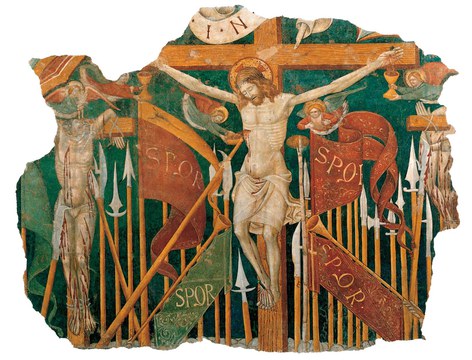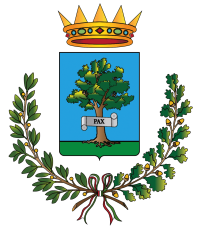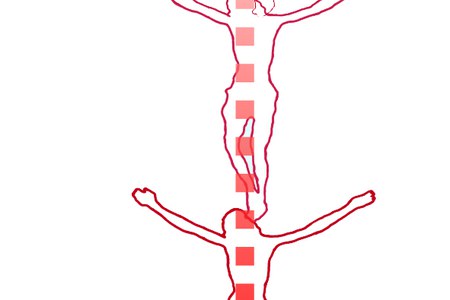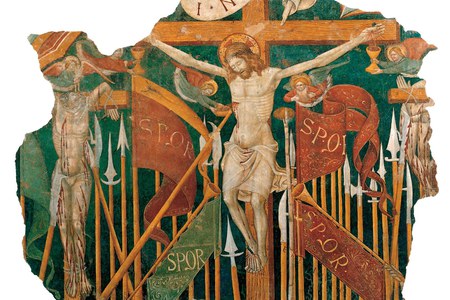The Crucifixion
 To get a complete overview of this work, visitors should linger on the explanatory panels displayed at the entrance hall of the Council Chamber. The Crucifixion exibited in Polverigi is the oldest painting in the Municipality and probably the most prestigious one. Found in a niche of the Municipal Palace, it is partially preserved thanks to a sheet of wall that, in 1826, an unknown mason erected in front of it, when the ancient "Church of the Crucifix" now lost, was incorporated into the Municipal residence. Since then, the altarpiece was forgotten, and it could not have been otherwise: because of the several tampering covering it the painting brought to life appeared to be of modest workmanship. Thus it remained in the municipal technical office until 1978 when following some visible clues, the Municipal Administration decided to carry out tests to see what the original work was. The painting turned out to be of very fine workmanship although about two-thirds of its surface were missing, and so it was decided to restore it. That unusual wall painting freed from the old structure that covered it, turned out to be a very valuable and highly original fifteenth-century fresco belonging to the period of the "gentle or courteous Gothic" developed in the Marche region between the beginning of the Renaissance and the early sixteenth century. The fresco immediately became the subject of study by Prof. Zampetti, the Italian leading expert on Renaissance painting, who placed it among the works of the "School of Ancona," which was active in the city due to work of some excellent painters from the Marche region, including Olivuccio di Ceccarello, to whom the critic was inclined to attribute it. As for the iconographic reconstruction, the President of the Municipal Media Library, Prof Rigotti has carried out comparative studies with works of the period and, thanks to the use of computer technologies and some key points fortuitously surviving in the fresco, has managed to reconstitute almost completely and with a good approximation the the painting. This large fragment is a part of a wide and monumental Crucifixion where the style and an exceptional and unusual iconography for the Marche region are powerfully characterized. In fact the painting represents the episode of the Crucifixion following the extensive and detailed narration made in the four Evangelists' account and thus depicts the two thieves crucified on Christ's sides, as well as an enormous crowd of soldiers whose helmets can be seen in a row, in addition to the forest of spears and flags. We have never seen in the Marche such a crucifixion so crowded, so crammed and packed with Roman soldiers, as we deduce from the acronyms in the flags, not even in Salimbeni brothers' great fresco at St. John's Oratory in Urbino, dated 1416. Its iconography is certainly taken from some northern Italian exemplars, where were, for exemple, the Piedmontese painter Jaquerio's pictorial compositions. From a stylistic point of view, the work is made according to the methods and expressive choices of the painter Giovanni Antonio Bellinzoni known as "from Pesaro", to whom it can be attributed thanks to comparisons with his certified works in Serra de' Conti (now in the National Gallery of the Marche in Urbino) and, above all, at St. Francis' church of Rovereto in the town of Saltara. In fact the author from Pesaro was frequently active in "Ancona border district", especially between the fourth and fifth decades of the fifteenth century, where he had to deal with the vast activity of that Olivuccio di Ceccarello hypothesized by Zampetti, with whose workshop Bellinzoni had perhaps specific contracts.
To get a complete overview of this work, visitors should linger on the explanatory panels displayed at the entrance hall of the Council Chamber. The Crucifixion exibited in Polverigi is the oldest painting in the Municipality and probably the most prestigious one. Found in a niche of the Municipal Palace, it is partially preserved thanks to a sheet of wall that, in 1826, an unknown mason erected in front of it, when the ancient "Church of the Crucifix" now lost, was incorporated into the Municipal residence. Since then, the altarpiece was forgotten, and it could not have been otherwise: because of the several tampering covering it the painting brought to life appeared to be of modest workmanship. Thus it remained in the municipal technical office until 1978 when following some visible clues, the Municipal Administration decided to carry out tests to see what the original work was. The painting turned out to be of very fine workmanship although about two-thirds of its surface were missing, and so it was decided to restore it. That unusual wall painting freed from the old structure that covered it, turned out to be a very valuable and highly original fifteenth-century fresco belonging to the period of the "gentle or courteous Gothic" developed in the Marche region between the beginning of the Renaissance and the early sixteenth century. The fresco immediately became the subject of study by Prof. Zampetti, the Italian leading expert on Renaissance painting, who placed it among the works of the "School of Ancona," which was active in the city due to work of some excellent painters from the Marche region, including Olivuccio di Ceccarello, to whom the critic was inclined to attribute it. As for the iconographic reconstruction, the President of the Municipal Media Library, Prof Rigotti has carried out comparative studies with works of the period and, thanks to the use of computer technologies and some key points fortuitously surviving in the fresco, has managed to reconstitute almost completely and with a good approximation the the painting. This large fragment is a part of a wide and monumental Crucifixion where the style and an exceptional and unusual iconography for the Marche region are powerfully characterized. In fact the painting represents the episode of the Crucifixion following the extensive and detailed narration made in the four Evangelists' account and thus depicts the two thieves crucified on Christ's sides, as well as an enormous crowd of soldiers whose helmets can be seen in a row, in addition to the forest of spears and flags. We have never seen in the Marche such a crucifixion so crowded, so crammed and packed with Roman soldiers, as we deduce from the acronyms in the flags, not even in Salimbeni brothers' great fresco at St. John's Oratory in Urbino, dated 1416. Its iconography is certainly taken from some northern Italian exemplars, where were, for exemple, the Piedmontese painter Jaquerio's pictorial compositions. From a stylistic point of view, the work is made according to the methods and expressive choices of the painter Giovanni Antonio Bellinzoni known as "from Pesaro", to whom it can be attributed thanks to comparisons with his certified works in Serra de' Conti (now in the National Gallery of the Marche in Urbino) and, above all, at St. Francis' church of Rovereto in the town of Saltara. In fact the author from Pesaro was frequently active in "Ancona border district", especially between the fourth and fifth decades of the fifteenth century, where he had to deal with the vast activity of that Olivuccio di Ceccarello hypothesized by Zampetti, with whose workshop Bellinzoni had perhaps specific contracts.


